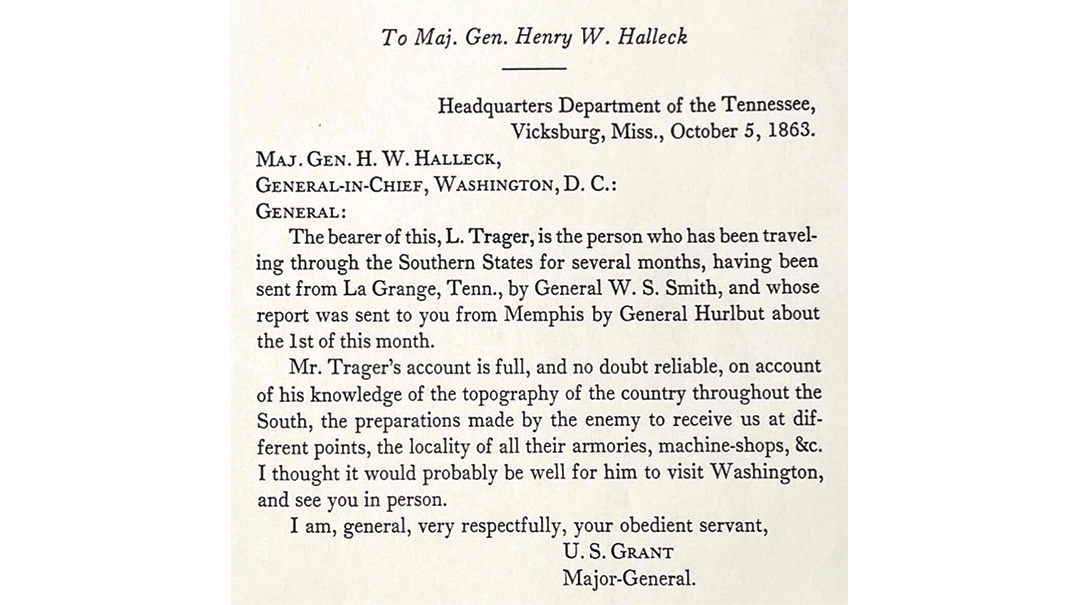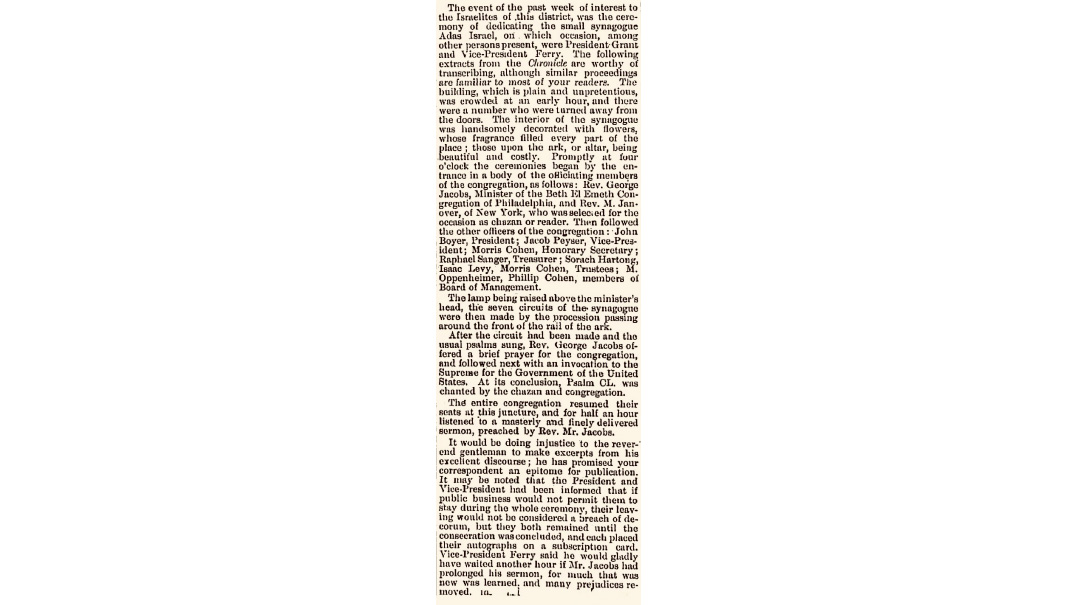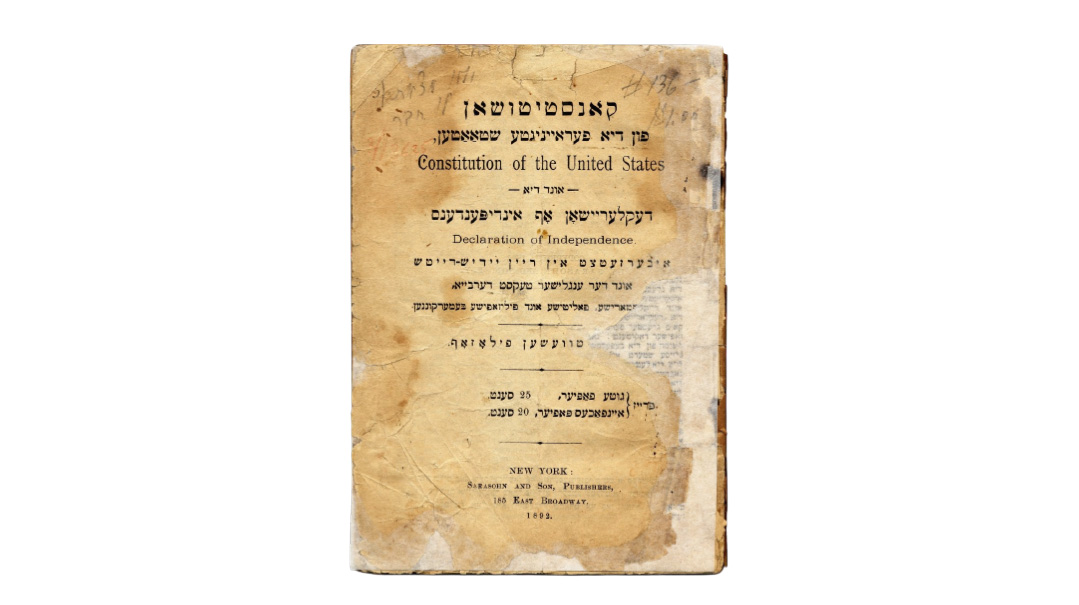From Vilna to Vicksburg
| August 9, 2022Unlikely figures to play important roles in the American Civil War

Title: From Vilna to Vicksburg
Location: Confederate States of America
Document: The Papers of Ulysses S. Grant
Time: 1860s (Civil War)
Avraham Yitzchok Trager and his son Aryeh Leib (Louis), born into the yeshivah world of Eastern Europe, were perhaps unlikely figures to go on to play important roles in the American Civil War.
Avraham Yitzchok (known as A.I.) was born in 1809 in Minsk. After spending his early years studying in a Vilna yeshivah, and then marrying and starting a family, he began to shuttle across Europe and the Middle East as a meshulach, raising funds for the Vilna Gaon’s talmidim who had settled in the Old City of Yerushalayim. During the course of A.I.’s two-year sojourn in Ottoman Palestine, his wife and children perished, and he traveled back to Vilna to try to restart his life. It was there that he married Shaina Esther Kornblum of Brisk, a descendant of the Tosfos Yom Tov.
In the late 1850s, A.I. Trager immigrated to New York, where he was among the founders of Beth Medrash Hagadol on the Lower East Side (a name he jokingly coined when there were merely a dozen member families). Rabbi Avraham Yosef Ash, the shul’s first rav and also a successful businessman, suggested that Trager join him in the hoopskirt trade, then booming due to new manufacturing technology that enabled higher-quality and more efficient production. The new endeavor met rapid success, and in 1860, the rest of the Trager family joined him in New York.
A few months later, A.I. brought most of the family with him south to Charleston, South Carolina, where one of the Trager enterprise’s four branches was then located. They could not have picked a less auspicious time to settle there.
On April 10, 1861, Confederate forces demanded the surrender of the Union garrison of Fort Sumter in Charleston Harbor. When their demands were not met, on April 12, Confederate batteries opened fire on the fort. At 2:30 p.m., April 13, Major Anderson surrendered Fort Sumter, evacuating the garrison on the following day. The Civil War was underway, and the Tragers were caught right in the thick of it.
A.I. Trager immediately took action, moving with his wife and youngest daughter Rachel inland to a farm in Columbia, South Carolina. Columbia’s Jews played an important role during those dangerous months, housing sifrei Torah and other valuables from the Charleston congregation as the city was shelled from the sea by the Union Navy.
Louis Trager, meanwhile, had not joined the family on their move south but had relocated to Chicago, to run the Midwestern branch of the Trager hoopskirt business. Then 17, the audacious, intelligent, Vilna-born youth felt unfulfilled in business, slowly beginning to cut himself loose and finding other ways to occupy his time.
Soon he was functioning as a freelance intelligence operative, purveying information to the Union Army that he picked up on business trips and family visits to the Confederacy. By October 1863, Louis had prepared a comprehensive report on Confederate army manpower, military installations, and ordinance. The report, which outlined the numerical strength of the Confederate army as well as fortifications, weaponry, and war production facilities in the South, soon reached the top generals in the Union.
In 1890, his report was published in the Official Records of the Union and Confederate Armies, and it’s from there that can glean how seriously General Ulysses S. Grant took the 20-year-old Trager’s findings. He gave Trager a personal letter of introduction to General Henry Halleck, the commanding general of the Union army, in which he wrote:
The bearer of this, L. Trager, is the person who has been traveling through the Southern States for several months, having been sent from Lagrange, Tenn., by Gov. W. S. Smith.... Mr. Trager’s account is full and no doubt reliable on account of his knowledge of the topography of the country... the preparations made by the enemy to receive us at different points, the locality of all their armored machine shops, etc. I thought it would probably be well for him to visit Washington and see you in person.
Eventually, Louis’s actions became known to the Confederates, and he was caught and arrested on the order of no less than General Robert E. Lee. It was then that his influential family came in handy.
A.I. Trager had a close friend named Benjamin Mordecai, a wealthy member of the Charleston Jewish community, who had made the first and largest contribution to the war chest of the Confederacy ($10,000). With Mordecai’s help and a sizable “ransom” payment, General Lee soon agreed to release the young spy. As for Benjamin Mordecai, he is remembered for spending much of his vast fortune in support of widows and children of soldiers, and was left penniless at the end of the war.
Reaping His Reward
After the war, Louis Trager briefly tried his hand in the cotton trade. Following Ulysses S. Grant’s election as president, Louis was rewarded for his Civil War heroism with an appointment as US consul to Boulogne, France, in 1872. But shortly after Trager arrived there with his family, economic conditions began to deteriorate. Financial panic struck Vienna in May 1873 and spread to other international money centers. European investors withdrew capital from the US, the Wall Street banking house of Cooke and Company failed, and some 5,000 American business firms had failed by year’s end.
In 1874 the US government, tightening its belt, abolished many minor consulates, including that in Boulogne. In 1882, Louis Trager was the Republican nominee for Congress for the Sixth District in Louisiana, but the state’s political corruption ensured that even as the more popular candidate, he would not win the hotly contested election. He passed away in 1905 and is buried in the Gates of Prayer Cemetery in New Orleans.
A Torah Sage Named Trager
When A.I. Trager passed away in 1913 at the ripe old age of 104, he was hailed by Orthodox Jews across the Eastern seaboard for his tremendous contributions to authentic Jewish life. For many years, he was the only ordained shochet and mohel in the region. His succah in Columbia was the only one in town, and he would invite all the locals to participate in the Yom Tov meals. But perhaps most importantly, he was one of the few truly learned people in mid-19th century America and utilized his knowledge to teach the masses Torah.
Following his death, his grandson Aaron Garfunkel paid tribute to him in the Yidishes Tageblatt:
My grandfather was intimately acquainted with the great gaon, Meyer Leibush Malbim of blessed memory, and always referred to him throughout his life. He was also personally acquainted with Sir Moses Montefiore of blessed memory, who was the one who chose him as the meshulach to collect funds for the Holy Land.
With a sort of prophetic knowledge of the trouble in store for his brethren in Russia, he bent all his energy and directed all his efforts in getting his friends over to this country one by one. He helped them with money and when they landed here, he was the great Machnis Orach and had many of them eat at his table and he gave them their first start in life.
For more on this story, see Hoopskirts & Huppas: A Chronicle of the Early Years of the Garfunkel-Trager Family in America, written by Milton M. Gottesman and published by the American Jewish Historical Society
Thank you to one of our favorite readers, Mrs. Debbie (Garfunkel) Popper, for introducing us to this fascinating story.
(Originally featured in Mishpacha, Issue 923)
Oops! We could not locate your form.







